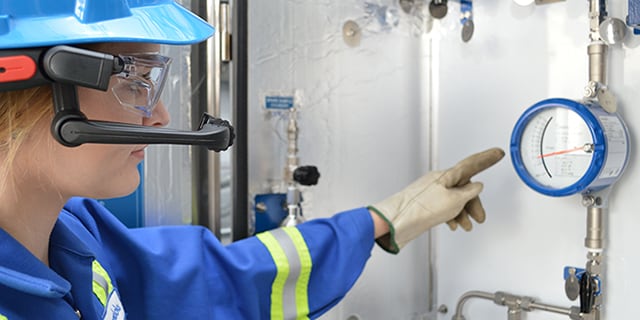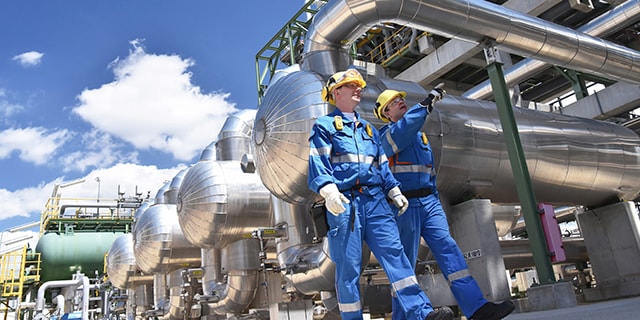Improve Maintenance with Valve and Hose Tags

How to Improve Your Maintenance Program with Valve and Hose Tags
Imagine you are a technician performing maintenance on an industrial fluid system. You receive a new work order—several hoses require attention in a certain application in the system.
You take a look at the relevant application, and you see upward of a dozen hoses carrying and valves controlling the flow of critical fluids from one place to the next, none of which are easily identifiable on sight. Some questions immediately arise:
- What types of fluids or gases are being transferred?
- Are those fluids at high pressures or temperatures?
- Are they potentially hazardous?
- How long has each hose been in service?
- What materials are the hoses made of—what sort of replacement is necessary?
Determining the answers to these questions may involve referencing system schematics and can require significant time and effort on your part. All the while, the application has been shut off to perform the maintenance work, creating downtime and lost profit potential.
This situation is emblematic of many fluid system applications. There is an easy solution, however: thorough tagging for all—even seemingly less critical—parts of your fluid system. We asked two Swagelok specialists to offer their unique perspectives on how tags can be leveraged for better outcomes and how you can work with your manufacturer to ensure the right information is included. Read on to learn the benefits you can achieve by adding tags to your hoses, valves, and other components, including more effective maintenance and improved system uptime.
A More Proactive Approach to Maintenance
Paul Stevens, field engineer, Swagelok Manchester, says:
“Most plants tag major fluid system components—items like pumps or other key components to system operation. But not all production facilities tag every item on site. Simple hose tags and valve tags can be beneficial, helping eliminate identification headaches for the maintenance team.
For example: If a maintenance technician is performing a routine checkup on a system involving multiple hoses, a good hose identification tagging system would let that tech know when each hose was last installed, its core material, what fluid it is carrying, and other critical information. Without tags, it’s a guessing game. A tech might deem each hose to be in good working condition because there are no obvious, visible issues.
However, there are often time-specific maintenance requirements for many regulators, hoses, and valves that a simple visual check might not identify. Leaving a hose or valve operating beyond its intended life could lead to an issue that maintenance teams are then responding to reactively. With tags, they can be more proactive by replacing a component before it fails.
Additionally, tagging can help identify specific issues or faults that have developed on site. By tagging and recording issues this way, there is both a record and a specific location that the maintenance team can use to quickly identify the item that needs to be replaced or worked upon.”
At a minimum, tags should be used to identify the part number, date of manufacture, and the trace identification number, which ties the product to the original order. System media, operating pressure, and temperature are also valuable information that can be included.
Greater Efficiency With the Right Information
Aaron Lindrose, Hose Technical Service, Swagelok, says:
“Tags are a cost-effective way to improve efficiency by allowing easy identification of products, and are effective in establishing preventive maintenance programs, but only when labeled with the right information.
At a minimum, tags should be used to identify the part number, date of manufacture, and the trace identification number, which ties the product to the original order. System media, operating pressure, and temperature are also valuable information that can be included. Some hose manufacturers will include this information as standard on every hose, and will offer several different tag styles to suit the individual plant’s needs, or those of their industry. For example, Swagelok offers several styles of tags that correspond to the markets we serve, from simple metal tags to color-coded tags that wrap around the hose near the end connection. We are also happy to help our customers solve all sorts of hose related challenges.
The tag type and size will dictate the amount of data that we are able to etch on the tag. The maximum amount of data possible is five lines of text and 25 characters per line, including spaces. If desired, tags can be encapsulated in silicone to minimize entrapment areas and facilitate ease of cleaning the hose exterior. With this information readily available, maintenance technicians can more easily and efficiently service their systems.”
Now, imagine our original scenario once again. You receive a work order for maintenance on an application involving several industrial hoses. This time, the answers to all your questions—about system media, operating pressure, original date of installation—are readily available and neatly contained within a tagging system. The job can be completed more easily and efficiently, and your system is back up and running much faster.
Interested in learning more about how to develop a more effective tagging system in your facility? Our specialists would be happy to help. Get in touch with your local authorized Swagelok sales and service center to find out how you can expedite maintenance, improve system safety, and minimize downtime today.
Related Articles

Your Industrial Fluid System Safety Checklist
Follow these best practices to enhance the safety of your industrial fluid system.

How to Isolate Industrial Fluid Systems with Block Valves
The isolation of industrial fluid system lines prior to maintenance is vital to plant safety. One of the safest ways to isolate a fluid system line is to install two block valves. Learn how to design proper configurations for your system.

Seven Tips for Effective Plant Turnarounds
A plant turnaround can be a big headache for a chemical plant or refinery—but it doesn’t have to be. Learn seven strategies for more effective turnaround management.

